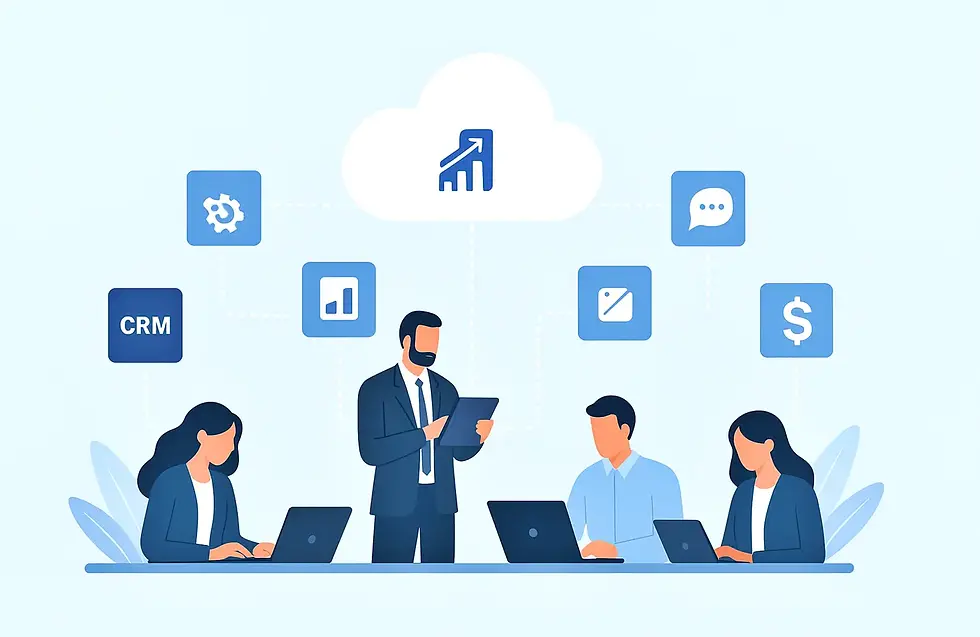What is B2B SaaS? Meaning, Examples & How It Works (2025)
- Kalyan Bhattacharjee

- Aug 16, 2025
- 3 min read

Overview
B2B SaaS (Business-to-Business Software as a Service) refers to cloud-based software solutions designed specifically for businesses to streamline operations, enhance collaboration, and drive growth.
Unlike traditional software, B2B SaaS platforms are accessible via the internet, require no local installation, and are typically offered on a subscription basis. In this blog, we’ll explore how B2B SaaS works, its key benefits, popular examples, and why it has become a backbone of modern business infrastructure.
What is B2B SaaS? (Business-to-Business SaaS)
B2B SaaS (Business-to-Business Software as a Service) refers to cloud-based software solutions designed specifically for businesses to use in their daily operations. Unlike B2C (Business-to-Consumer) SaaS, which targets individual consumers, B2B SaaS products are built to address the needs of companies, teams, or entire enterprises.
In essence, B2B SaaS allows businesses to access and use software over the internet on a subscription basis. These platforms typically run on the vendor's servers (cloud) and are accessible via web browsers, eliminating the need for businesses to install or maintain software locally.
How Does B2B SaaS Work?
B2B SaaS applications operate through a cloud computing model. Here’s how it generally works:
Subscription-Based Access: Businesses subscribe to the software on a monthly or yearly plan, based on their usage needs or number of users.
Cloud Hosting: The SaaS provider hosts the software and manages infrastructure, updates, security, and scalability.
Multi-Tenant Architecture: Multiple customers (tenants) share the same infrastructure and application codebase, while data is kept separate and secure.
APIs and Integrations: B2B SaaS often integrates with other enterprise tools like CRMs, ERPs, and productivity platforms through APIs.
User Management & Collaboration: These tools often support multiple users, role-based permissions, and team collaboration features.
Key Benefits of B2B SaaS
Scalability: Easily scale up or down as your business grows.
Cost-Efficiency: Lower upfront costs as there's no need to invest in physical infrastructure.
Accessibility: Access from anywhere with an internet connection.
Automatic Updates: Providers handle software updates and maintenance.
Security: Robust security and compliance features are often included.
Examples of Business-to-Business SaaS Products
Salesforce – A leading CRM (Customer Relationship Management) tool used by sales teams to manage leads, deals, and customer interactions.
Slack – A communication and collaboration platform for businesses.
HubSpot – Inbound marketing, sales, and customer service software.
Dropbox Business – Cloud storage and file-sharing services for organizations.
Trello (Enterprise) – Project management and team collaboration tool.
Zoom – Video conferencing software tailored for business meetings and webinars.
Common B2B SaaS Use Cases
Customer Relationship Management (CRM)
Enterprise Resource Planning (ERP)
Human Resource Management (HRM)
Marketing Automation
Accounting & Finance Software
Data Analytics and BI Platforms
Challenges in B2B SaaS
Churn Management: Retaining business clients can be difficult without regular engagement.
Complex Onboarding: Enterprises may need training or custom implementation.
Security & Compliance: SaaS companies must comply with strict regulations like GDPR or HIPAA.
Integration Needs: Clients often demand integration with existing legacy systems.
Future of B2B SaaS
AI and Machine Learning: Intelligent automation, smart insights, and predictive analytics are becoming mainstream in B2B SaaS.
Vertical SaaS: Tailored solutions for specific industries (e.g., healthcare, finance, logistics) are gaining traction.
Low-Code/No-Code Platforms: Allow businesses to create custom apps without deep programming knowledge.
Improved UX/UI: B2B SaaS is adopting more consumer-like interfaces for better usability.

Key Takeaways
B2B SaaS has revolutionized how businesses operate, offering scalable, flexible, and cost-effective software solutions for nearly every function within an organization. As digital transformation continues to evolve, B2B SaaS will remain a cornerstone of modern business infrastructure, enabling companies to innovate, collaborate, and grow more efficiently than ever before.
Whether you're a small startup or a large enterprise, adopting the right B2B SaaS tools can significantly enhance productivity, streamline operations, and provide a competitive edge in today's digital economy.
b2b saas, software as a service companies, saas providers, saas softwares, b2b saas marketing agency, b2b saas, b2b saas ai startup investment criteria, b2b saas meaning, b2b saas marketing, what is b2b saas, what is saas and b2b, what is a b2b saas company, what does b2b saas mean, how to generate demand for a b2b saas, what is saas and b2b, saas company meaning, b2b software companies, b2b software, fintech shield




Comments